E/In Motion
performance
solo project (part of Master’s thesis, Mentor: prof. Dusan Kirbis)
June 2019, duration 20-30 min Ljubljana, Slovenia; premiered June 28th, 2019 on the Left Stage of SNG Drama in Ljubljana. (link)
author: Nika Batista
performers: Nika Batista, Tatiana Kocmur, Julija Hoda, Urska Medved
Performace was built on the idea of visualization of emotions. There are three chosen emotions; melancholy, intimacy, and admiration. Starting goal was to have an approximately balanced harmony of design and art throughout the whole project. To create a subtle moment when my inner understanding of those emotional states comes out for others to see and hopefully feel.
Breathing.
Breathing their inevitable presence.
The awareness is subtle yet prolonged.
Duration is limited by the circumstances surrounding it.
Sometimes it seems like I have no control over them.
Sometimes I worship them, sometimes they solidify my own existence.
Feeling of helplessness that I can’t dilute the density in my head- melancholy.
Consequences of all mental processes that are underneath the level of superficial- admiration. Here words are not used any more- intimacy.
I’m conducted by them and I have conducted them.










photos: Valentina Cunja
Visualization of three selected long-lasting emotions: intimacy, melancholy, and admiration. The aim is to present a project where art and design are equally represented. Each long-lasting emotion is basically visually represented in three parts: the textile panel with pattern manipulation, the performer's clothing, and the performative part. I named it E/IN MOTION and it premiered on June 28, 2019, on the Left Stage of SNG Drama in Ljubljana.
The clothing was, similarly to the panels, mostly black. The deprivation of color can initiate which emotion is taken for inspiration. I have taken away the observer's subconscious knowledge of colors, with a desire to divert attention to subtlety in materials, clothing, and movement, thus presenting my message. The subtlety was not meant for movement and design only, but also to communicate my intentions. In addition to the specific shape, stiffness, and softness, an important factor for me was also the limited/unlimited movement in the clothes according to a specific emotion. Communicating the performance and clothing was as important to me as communicating through body movement in clothing.
Intimacy is the only of the three selected emotions that I have tied to someone else, something else, or to some other space. She briefly touches me during the performance before inserting her hands inside the sleeve of the associated panel.
Melancholy often plays a role when encountering works of art and can also be important in aesthetic responses to the natural environment. The complexity of melancholy fascinates the continuation of my think- ing and my perception of it. The melancholy in the performance takes up space below the knees, its movement like crawling on the ground, up until the moment it wraps itself in the drapery of the corresponding panel. Perception-based on observation/hearing/touching is essential to admiration. These are tied to a third person but not related to them. There can also be the admiration of just one part of the whole, of a particular skill, of a particular creation, or of a created product. In the performance, admiration is stoic and upright, its steps confident. The performer that illustrates that feeling makes direct eye contact with the visitors, unlike the other two depictions of emotions.
The starting position where visitors entered the space was constructed of three hanging panels of textiles, each belonging to a corresponding emotion. Long strips of cloth stretched between them and my hands. Tied to my wrists, my knees bent, facing down, I lay there with my face turned to the ground. There was a sound like breathing in the background.
A different visual image of my emotions would have most certainly been expressed only a few months after the E/IN MOTION performance: different colors, silhouettes, details, materials, touches, other words, and movements. Other purposes and reasons. And I would still argue that the same emotions are expressed sincerely and unjustifiably. As far as I am concerned, their complexity does not allow for a conclusion where the final sentence is not followed by anything.
The same sentence I started and finished the project with:
»Without human emotions, there has never been, is not, and will never be a human search for truth.« (Lenin, 1966)

